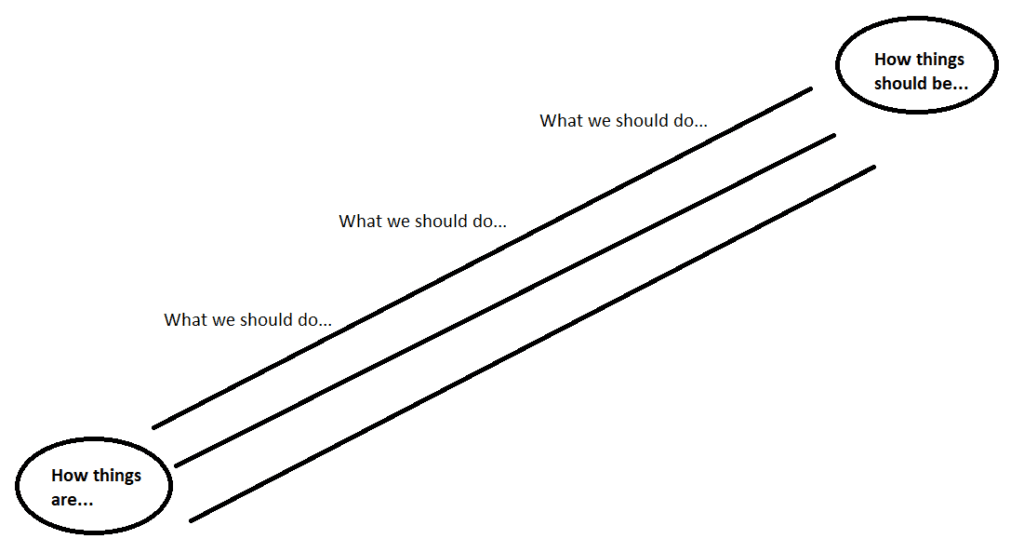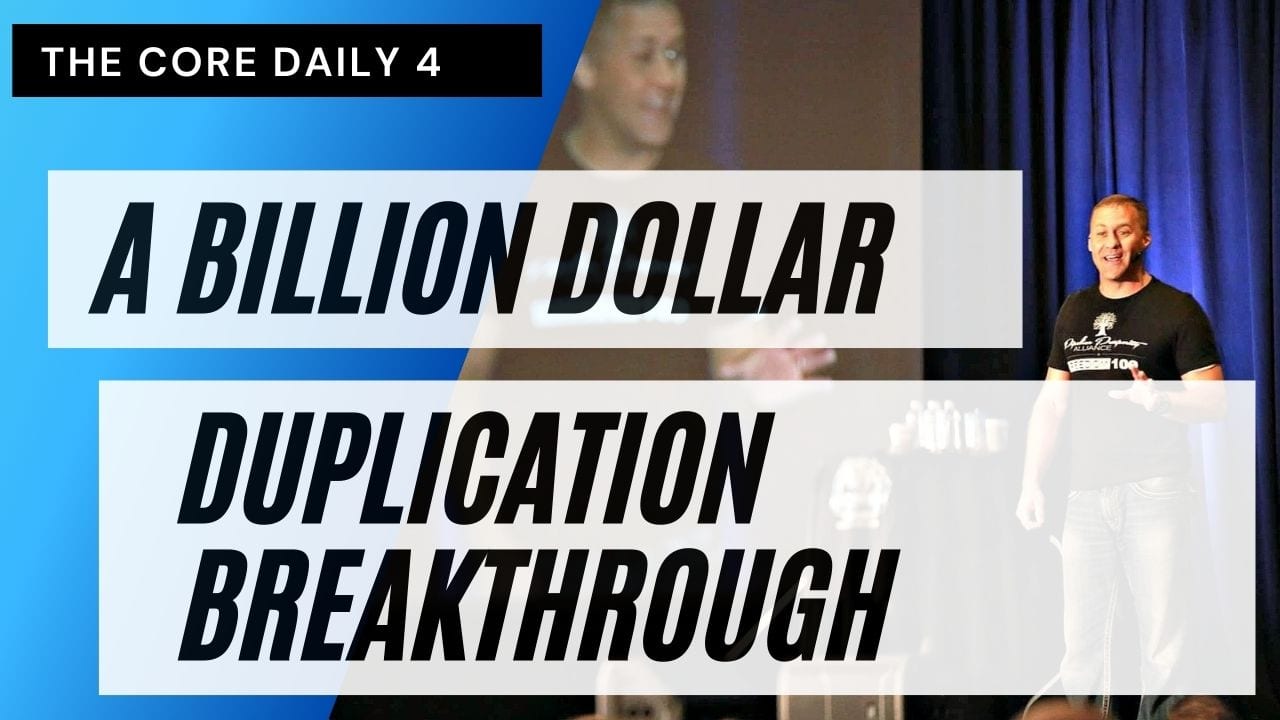Hey friends and fellow freedom crusaders in today’s post, I want to share with you a billion dollar breakthrough.
I used to work at a very successful, famous network marketing company.
I learned something while I was there, That I didn’t really learn.
And the reason I say I didn’t really learn it is because I didn’t necessarily apply what it was that I was made aware of.
This breakthrough can be super helpful for anyone working on building and leading groups of people.
So what was the breakthrough?
I was recently reading this book by a world renowned psychotherapist, and he had this diagram in this book that might sound simple and it is simple, but it has some really deep and far reaching ramifications for how we live our lives, how we communicate, how we lead.
So basically, if you can imagine a sheet of paper, not, up and down, but turned sideways.
So it’s kind of like landscape view, and then in the bottom left, you have a little circle and in that circle, you draw current situation or how things are or where I’m at.

Basically that circle is just meant to describe the way things are.
And then on the top, right of that sheet of paper, you’ve got another circle that says, the way things should be and then in between the way things are and the way things should be, you have lines, let’s imagine three or four lines going from circle one to circle two.
And on each of those lines as written the following, how we should act, how we should act, how we should act.
This diagram is really profound because this psychotherapist has, as far as I know, no exposure to network marketing, affiliate, marketing, personal development, and yet what he was describing in this diagram is the fundamental human condition.
Where we all find ourselves in a certain spot in time, and we may find certain aspects of that certain spot undesirable, or maybe even unbearable.
And the goal is to see something better, right?
Have a vision.
The Bible says where there is no vision, the people perish.
So we see how things could be or how things should be.
And then the difference between where we’re at now to how things should be, or how things could be, is what we do, on that path.
How we should act, how we should act.
How we should act.
And so, as I was looking at this diagram, I was thinking about this billion dollar company that I used to work at.
It was a very successful network marketing company.
The Clue
One thing that this network marketing company had in place is they had this list of critical business building activities, and it had things on it, like,
- step number one, always be building your contact list.
- Step number two, be giving invitations.
- Step number three, be following up
- step number four, always attend the events and the meetings.
And there was a list of seven or so of these critical business building activities.
When I saw this diagram, my breakthrough was that this billion dollar company that I was working at had answered the questions, how we should act, how we should act, how we should act in a format that was embedded within the culture.
And in this company, you couldn’t go to a meeting without these critical business building activities being talked about and trained on.
And here’s the big aha moment…
We all wake up in the morning and we wonder, what should we do?
You know, we’ve got these goals, you’ve got these dreams and we’re wondering “what we should do, to get there..”
Leadership, at least in part is helping people answer those questions.
And so if you’re building a team where you’re leading a group of people,
What you don’t want is you don’t want people waking up in the morning and asking themselves what should I do?
And then, Not knowing the answer, being confused, stumbling around in the dark a little bit, not confidently moving forward.
What you want is you want people waking up and knowing, okay, here are the steps that I’m going to take today.
How I should act, how I should act, how I should act.
And if I do this consistently over time, these are the steps that will lead me to that vision of how things should be, how things could be.
And so, in an organization, in a culture, best case scenario is you come up with a list of things that will instruct the people that you’re serving as to what they should do, what they should do, what they should do every single day.
And if you can do it in a way where those items are simple, easy to remember, easy to do, and also, Somewhat ambiguous in the sense that they can be applied in various ways,
Then what you can create is a situation where everyone in the community knows how we should act, how we should act, how we should act.
And so everyone has clarity when they wake up in the morning, they know what they’re supposed to do. And if they’re easy to remember, everybody’s remembering them there. They’re easy to remember. So they’re easy to teach. Everyone’s talking about them. And then you create a culture that has this action plan, embedded inside of the culture.
So the message per perpetuates to perpetuity and really serves everyone, in the very best way.
And the reason that I think that some of these steps might want to be a little bit ambiguous is because people are different and people are going to do things and want to do things in their own way.
But if you can have a basic framework, a step that people know, okay, I need to do step number one, step number two, step number three, but then how I actually do step number one, step number two, step number three is up to me, I have some freedom as to how I want to do that, then I think that’s a good thing.
So we have four things that we believe we should do, and we should encourage others to do, to help them to get to where we think, how things should be, which in our company, our vision is freedom through principle-centered leadership. We want to help everyone build a life of freedom and do it in a principle centered way.
So they enjoy the journey so that they are happy with the activities that they’ve performed and the way that they’ve treated people on the way.
And so that’s the vision, and so the question is what should people do on a daily basis to get them to that vision?
And I just want to share these with you as food for thought, you don’t have to do these exact steps, but again, if you’re leading an organization or a group of people, It’s really important that you identify the activities that you want people to do to help them to get to where you want them to go.
And again, here’s the thing that you don’t want.
So if you’re in a group right now, a company, a team, what you don’t want is you don’t want to go to person a and say, okay, what’s the, how we should act.
And then person a gives this answer, That is totally different from person B and totally different from person C and totally different from person D.
If you have that scenario happening, then everyone in the organization has a different idea as to what should be done on a daily basis, And that doesn’t create unity.
And it also means that the message from the leadership is not clear and it’s not reaching the people in the way that it should.
And so clarifying these steps and embedding them within the culture can make it so, When you ask person a person, B person C, Hey, what should we do?
What should we do?
What should we do?
You get the same answer from every single person.
Now that might be applied in a little bit of a different way, but at least you’re getting the core activities down, within your group.
Example: Our List – The Core Daily Four
And so what were the four that we’re settling on? Number one, build your audience daily.
1. Build Your Audience
So every day, Wake up and serve your audience, speak a message that will lift them and empower them. Speak a message that will help them be inspired and empowered on their journey forward. So wherever you’re wanting to get people, build that audience, spread the message on social media, send emails to your lists, do trainings.
You’re building your audience. You’re serving people, and this is important in business building because it seems that more and more a lot of the rapport happens on social media.
It happens on YouTube.
It happens on Twitter.
It happens on Facebook before they get to your email list.
If you’re building that audience every day, What can happen is people get to know like, and trust you.
They like to follow you.
And they will accept whatever recommendations you give them.
As long as those recommendations can help them get to where they want to go.
So build your audience daily.
The next step after build your audience daily would be to
2. Build your specialized knowledge daily.
Why is it that an audience will follow you?
At least, in part, It’s because you have specialized knowledge that can help them get to where they want to go.
So every day you build that specialized knowledge, it’s not general knowledge.
And here’s a great example of general knowledge. If you’ve ever watched the TV show called cheers, where this whole drama plays out in this bar scenario, and there’s this one character called Cliff and he’s a mailman and he’s sitting there with all his buddies.

And one of the things that cliff always does is he always spits out these random general facts about history and the world.
He’ll say things like, ‘well Normie, as a matter of fact, back in 1925, this happened and, and he spits out these random facts.’
And what happens is everyone in the bar kind of gets annoyed and bored with cliff because he’s always, spitting out general knowledge, right?
General knowledge people don’t tend to find very valuable, but if your knowledge is specialized, if you have specialized knowledge to serve an audience that has a desire or a problem that you can help solve.
Now, all of a sudden you’re attracting people to you because you’re putting yourself in your message in a way that’s useful to other people, right?
So build your audience, build your specialized knowledge every day.
3. Build your business every day.
How do you build your business? All a lot of different ways.
If you’re in network marketing, you’re meeting people, you’re giving invitations.
If you’re doing it on the internet, you’re sending emails out.
You’re giving PS calls to action, hey PS, if you’re open to another exciting income stream, click here and take a peek at this cool video, you’re giving calls to action for people to actually look at what it is that you’re doing so that you can gather them as a customer or gather them as a business partner or gather them as an affiliate.
That’s build your business and you definitely want to be doing that every single day.
And then the fourth B that we came up with for our daily action steps is to
4. Build Your Community
Build your community.
Our first three are about customer acquisition.
Build community is what you do after people are in the door.
You want to help them feel welcome.
You want to help them feel like people care about them.
You want to make sure their questions are answered.
You want to reinforce the community vision.
You want to follow the community culture.
You want to attend the events right?
This is all building community and building community is super important for a whole number of reasons, not the least of which if people feel welcomed in a group and accepted and loved and cared about, and they feel like their needs are getting met, then they are much more likely to stick and stay for the long haul.
And that provides retention.
It also gives them time enough, in the group and in the journey to learn what they need to learn so they can do what they need to do so that they can achieve the goals that they want.
So it’s super important to also build a community.
So those were just an example of our four daily steps.
What are your four daily steps in your business?
What is it that you do on a daily basis?
What is it that you want people to do?
Comment down below.
And if you’re not quite sure, this is the perfect time to answer these questions, not just for yourself, but for everyone else that you’re going to be serving as you continue the freedom journey.
So that’s it my friend!


Great Content Paul.
Thank you Elizabeth!